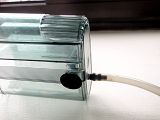throw away all of the filter media that it comes with.
I have a few of these filters. *
When I use yeast, (DIY CO2) or pressurized CO2, I run the filter as an internal reactor/needlewheel.
Parts are interchangeable for both these filters, so I scavenged the DJ100's larger impeller and filtration housing.
It's difficult to say if they are worth the expense for diy people.
If there still available, they can sometimes be expensive for a powerhead.
Still, it's a quick and effective solution.
Tools for this project are;

- needle nose pliers
- a flat head screwdriver
- any drill, auger or power drill
- and one insert coupling, (little black thing that comes with the filter).
Or, just stuff the air hose in the opening.

First:
The filter attaches horizontally against the tank. Horizontally,

allowing DIY CO2 to escape when the pump is not running - very nice for yeast reactors.
- The filter's suction cups are mounted on either side of the filter with just the removal of two punch outs. Pry off the top of the lid and remove the tabs if you need to keep the filter's intake vent up and parallel to the water's surface.


Next:
Make the reactor.
- Using a power drill or hand tool, drill an opening to the largest chamber, directly across from the impeller.
Now that you have an opening for a CO2 line.
Snap the filter back together, insert the CO2 line, check valve (for diy, use a cv with a low cracking pressure) and your done.
"Counting Bubbles"
http://youtu.be/RH4Po_gSNCQ
Most of the CO2 diffuses into solution. There is a small pocket of air that stays in the chamber.
I notice micro-bubbles at fairly high gas rates if the air pocket is big enough to be sucked into the impeller.
"What's to Like…"
- A small and efficient reactor for diffusing CO2.
- Easy to make with simple tools.
- No need for a bubble counter and a relatively small size powerhead to better circulate CO2.
- When the pump is turned off by the timer, CO2 in the main chamber gasses off through the intake vent.
- The CO2 line attaches to the filter in a way to create a venturi effect.
This pressure difference in the line is very helpful w/diy sluggish fermentations. - Easy to clean when a yeast/DIY is providing CO2.
* The Duetto is no longer manufactured, Post #11 explains the work-around for modifying the Fluval Nano filter.







